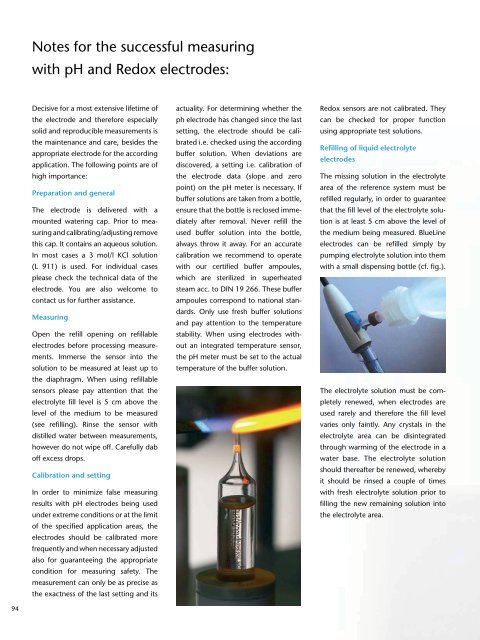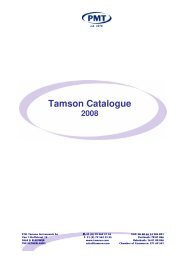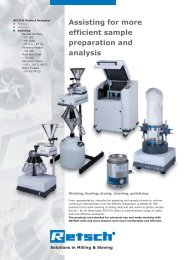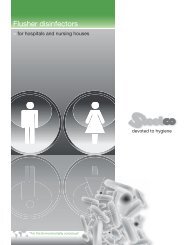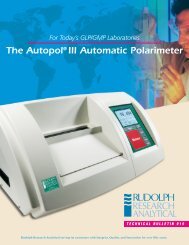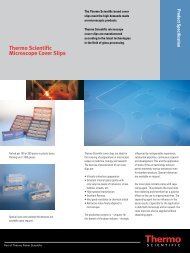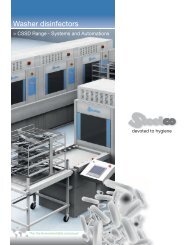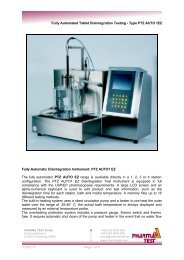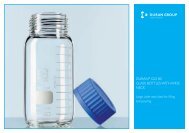Laboratory Products
Laboratory Products
Laboratory Products
You also want an ePaper? Increase the reach of your titles
YUMPU automatically turns print PDFs into web optimized ePapers that Google loves.
Notes for the successful measuring<br />
with pH and Redox electrodes:<br />
Decisive for a most extensive lifetime of<br />
the electrode and therefore especially<br />
solid and reproducible measurements is<br />
the maintenance and care, besides the<br />
appropriate electrode for the according<br />
application. The following points are of<br />
high importance:<br />
Preparation and general<br />
The electrode is delivered with a<br />
mounted watering cap. Prior to measuring<br />
and calibrating/adjusting remove<br />
this cap. It contains an aqueous solution.<br />
In most cases a 3 mol/l KCl solution<br />
(L 911) is used. For individual cases<br />
please check the technical data of the<br />
electrode. You are also welcome to<br />
contact us for further assistance.<br />
Measuring<br />
Open the refill opening on refillable<br />
electrodes before processing measurements.<br />
Immerse the sensor into the<br />
solution to be measured at least up to<br />
the diaphragm. When using refillable<br />
sensors please pay attention that the<br />
electrolyte fill level is 5 cm above the<br />
level of the medium to be measured<br />
(see refilling). Rinse the sensor with<br />
distilled water between measurements,<br />
however do not wipe off. Carefully dab<br />
off excess drops.<br />
Calibration and setting<br />
In order to minimize false measuring<br />
results with pH electrodes being used<br />
under extreme conditions or at the limit<br />
of the specified application areas, the<br />
electrodes should be calibrated more<br />
frequently and when necessary adjusted<br />
also for guaranteeing the appropriate<br />
condition for measuring safety. The<br />
measurement can only be as precise as<br />
the exactness of the last setting and its<br />
actuality. For determining whether the<br />
ph electrode has changed since the last<br />
setting, the electrode should be calibrated<br />
i.e. checked using the according<br />
buffer solution. When deviations are<br />
discovered, a setting i.e. calibration of<br />
the electrode data (slope and zero<br />
point) on the pH meter is necessary. If<br />
buffer solutions are taken from a bottle,<br />
ensure that the bottle is reclosed immediately<br />
after removal. Never refill the<br />
used buffer solution into the bottle,<br />
always throw it away. For an accurate<br />
calibration we recommend to operate<br />
with our certified buffer ampoules,<br />
which are sterilized in superheated<br />
steam acc. to DIN 19 266. These buffer<br />
ampoules correspond to national standards.<br />
Only use fresh buffer solutions<br />
and pay attention to the temperature<br />
stability. When using electrodes without<br />
an integrated temperature sensor,<br />
the pH meter must be set to the actual<br />
temperature of the buffer solution.<br />
Redox sensors are not calibrated. They<br />
can be checked for proper function<br />
using appropriate test solutions.<br />
Refilling of liquid electrolyte<br />
electrodes<br />
The missing solution in the electrolyte<br />
area of the reference system must be<br />
refilled regularly, in order to guarantee<br />
that the fill level of the electrolyte solution<br />
is at least 5 cm above the level of<br />
the medium being measured. BlueLine<br />
electrodes can be refilled simply by<br />
pumping electrolyte solution into them<br />
with a small dispensing bottle (cf. fig.).<br />
The electrolyte solution must be completely<br />
renewed, when electrodes are<br />
used rarely and therefore the fill level<br />
varies only faintly. Any crystals in the<br />
electrolyte area can be disintegrated<br />
through warming of the electrode in a<br />
water base. The electrolyte solution<br />
should thereafter be renewed, whereby<br />
it should be rinsed a couple of times<br />
with fresh electrolyte solution prior to<br />
filling the new remaining solution into<br />
the electrolyte area.<br />
94


